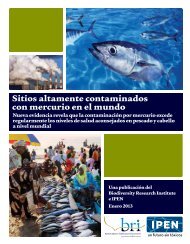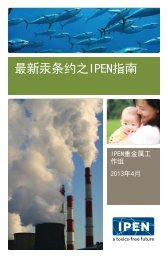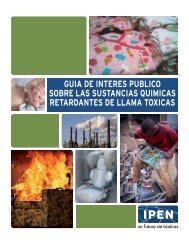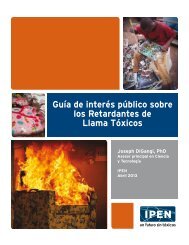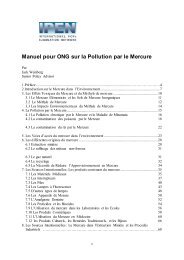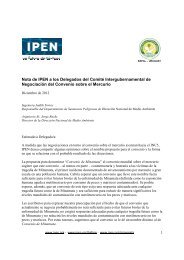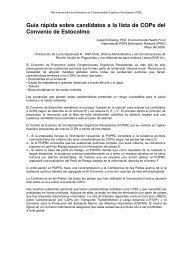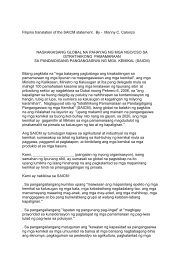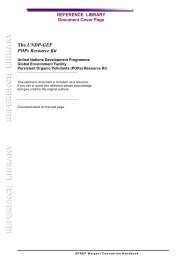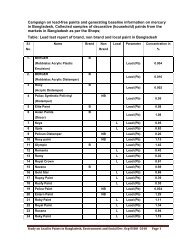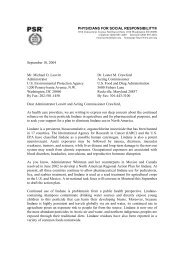A Public Interest Guide to Toxic Flame Retardant Chemicals
A Public Interest Guide to Toxic Flame Retardant Chemicals
A Public Interest Guide to Toxic Flame Retardant Chemicals
Create successful ePaper yourself
Turn your PDF publications into a flip-book with our unique Google optimized e-Paper software.
their body as the general public. The New York Times investigated the issue and found<br />
that according <strong>to</strong> the industry, 12.3 billion pounds (~6 billion kg) of recycled foam carpet<br />
padding is in homes and offices in the US alone.<br />
6.3 DUMPING OF NEAR-END-OF-LIFE AND END-OF-LIFE ELECTRICAL AND<br />
ELECTRONIC PRODUCTS RELEASES TOXIC FLAME RETARDANT CHEMICALS<br />
Near-end-of-life and end-of-life electrical and electronic products are a growing concern<br />
as a result of dumping in developing countries, which results in the illegal transboundary<br />
movement of <strong>to</strong>xic substances such as metals and <strong>to</strong>xic chemical flame retardants.<br />
More than 110 countries agreed that this represented a serious problem in a formal decision<br />
taken at the Second International Conference on <strong>Chemicals</strong> Management in 2009<br />
<strong>to</strong> develop recommendations for global action. Electronic waste is the fastest growing<br />
waste stream in the world with rates three times faster than municipal solid waste. Approximately<br />
20 – 50 million <strong>to</strong>nnes a year of electronic<br />
waste is generated and large amounts are dumped in<br />
Asia and Africa. The subsequent recycling operations<br />
cause large chemical exposures <strong>to</strong> workers including<br />
women and children as well as environmental contamination.<br />
6.4 LACK OF CAPACITY TO HANDLE<br />
ELECTRONIC WASTE<br />
There is a lack of capacity <strong>to</strong> handle electronic waste<br />
in an environmentally sound manner in almost all<br />
developing countries and countries with economies in<br />
transition. Many developed countries also struggle <strong>to</strong><br />
address this growing waste stream. This leads <strong>to</strong> the release of hazardous substances<br />
that cause harm <strong>to</strong> human health and the environment. More than 110 countries agreed<br />
that this represented a serious problem in a formal decision taken at the Second International<br />
Conference on <strong>Chemicals</strong> Management in 2009.<br />
6.5 WASTES CONTAINING FLAME RETARDANTS WITH POPS PROPERTIES<br />
SHOULD NOT BE TRANSPORTED ACROSS INTERNATIONAL BOUNDARIES<br />
UNLESS IT IS FOR PROPER DISPOSAL<br />
In 2009, a major debate erupted at the S<strong>to</strong>ckholm Convention 5 th Conference of the<br />
Parties over whether wastes containing flame retardants could be exported <strong>to</strong> developing<br />
and transition countries. The 53 countries of the African group, led by Kenya,<br />
pushed developed countries <strong>to</strong> ensure that wastes containing <strong>to</strong>xic flame retardants<br />
are not exported <strong>to</strong> Africa. Kenya proposed the ban after the treaty expert committee<br />
recommended ending the practice of recycling products containing flame retardants<br />
and s<strong>to</strong>pping their export. After a long debate, delegates agreed on text that encourages<br />
countries <strong>to</strong> ensure that waste materials containing PBDEs listed in the treaty are<br />
not exported <strong>to</strong> developing and transition countries. The decision cites the treaty text<br />
which notes that POPs can only be transported across international boundaries for the<br />
purpose of environmentally sound disposal in such a way that the POPs content is destroyed<br />
or irreversibly transformed.<br />
Image courtesy of BAN.org<br />
A PUBLIC INTEREST GUIDE TO TOXIC FLAME RETARDANT CHEMICALS<br />
17



